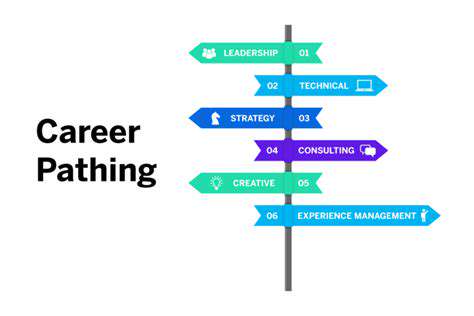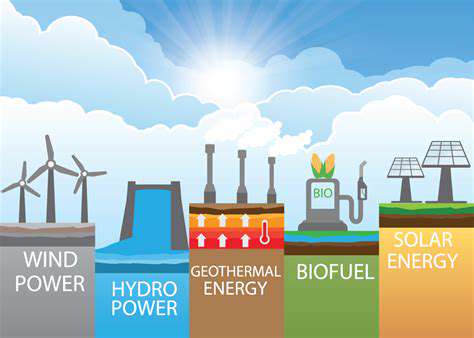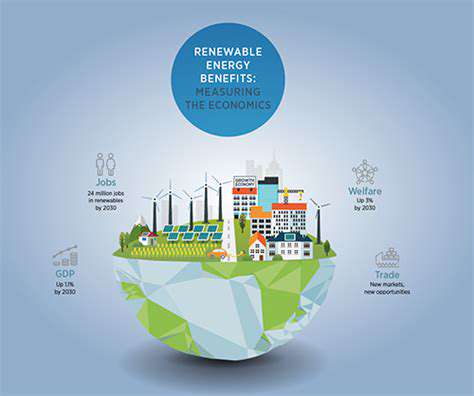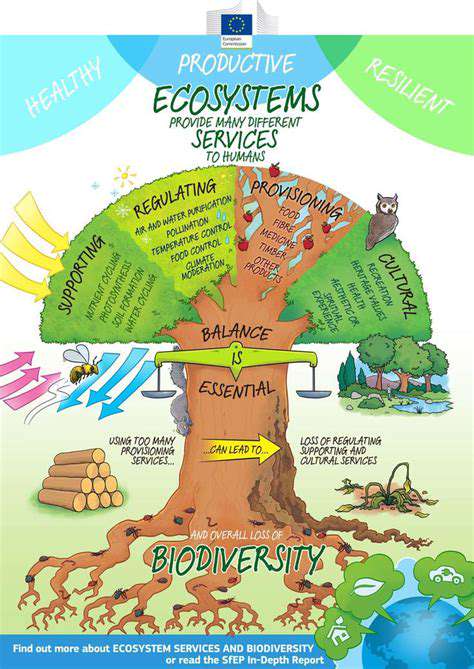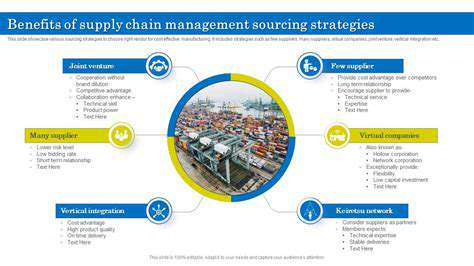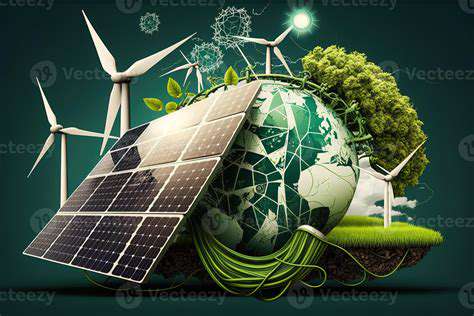Wind Energy Advancements: Driving the Global Energy Transition
Advanced Blade Designs for Enhanced Aerodynamics
Modern turbine blade designs are pushing the boundaries of aerodynamics, incorporating sophisticated shapes and materials to maximize energy capture. These advancements, often utilizing computational fluid dynamics (CFD) simulations, lead to significantly improved lift and reduced drag. This translates directly to higher energy yields from the wind, even in moderate wind conditions, a critical factor in maximizing the economic viability of wind farms.
Furthermore, new blade materials, such as carbon fiber composites, are lighter yet stronger than traditional materials. This reduced weight translates to a lower overall turbine mass, allowing for larger rotor diameters and, consequently, more swept area to capture the wind. This increase in swept area is a key driver in boosting the turbine's capacity and overall energy generation.
Variable Speed Drive Systems for Optimized Power Output
Traditional fixed-speed turbines can struggle to maintain optimal power output across a wide range of wind speeds. Variable speed drive systems (VSDs), however, intelligently adjust the turbine's rotational speed in response to fluctuations in wind conditions. This allows the turbine to extract maximum energy from varying wind speeds, significantly increasing overall energy production and efficiency compared to fixed-speed systems.
VSDs also help to reduce wear and tear on the turbine components by mitigating the stress associated with sudden changes in wind speed. This improved reliability translates to longer operational life and reduced maintenance costs, making VSDs a crucial element in the evolution of turbine technology.
Smart Grid Integration and Energy Storage Solutions
The increasing integration of wind energy into the power grid requires sophisticated solutions for managing the fluctuating nature of wind generation. Smart grid technologies, including advanced forecasting models and real-time grid management systems, help to effectively integrate wind power into the existing infrastructure. This reliable integration is essential for the widespread adoption of wind energy, and it paves the way for a more sustainable energy future.
Furthermore, integrating energy storage solutions with wind turbines is becoming increasingly important. These solutions, such as batteries and pumped hydro, can store excess energy generated during periods of high wind and release it during periods of low wind, ensuring a consistent and reliable power supply. These advancements in energy storage are critical for achieving grid stability and for the wider deployment of renewable energy.
Innovative Gearbox Designs and Lubrication Techniques
Gearboxes are crucial components in wind turbines, transmitting power from the rotor to the generator. Recent innovations in gearbox design focus on enhancing durability and reducing maintenance requirements. These improvements often incorporate advanced materials and optimized designs, aiming to mitigate wear and tear, and extend the operational lifespan of the gearbox.
Furthermore, advancements in lubrication techniques are critical in extending the lifespan of gearboxes. The use of specialized lubricants, coupled with advanced monitoring systems, can significantly reduce friction and wear, extending the operational life of these essential components. This leads to fewer maintenance outages and lower overall operational costs.
Offshore Wind Turbine Technologies for Enhanced Capacity
Offshore wind farms present unique challenges and opportunities for turbine technology. Advanced designs are crucial for withstanding harsh marine environments, and offshore turbines are now equipped with robust structures and specialized components to withstand high winds, waves, and salt spray. These features are vital for the successful operation of offshore wind farms, which often produce more energy due to stronger and more consistent winds.
Additionally, innovations in installation and maintenance techniques for offshore turbines are significant factors in reducing costs and improving reliability. These advancements, combined with the potential for higher wind speeds in offshore locations, result in a dramatic increase in energy production capacity.
Offshore Wind Farms: Expanding the Horizons of Renewable Energy

Offshore Wind Farms: A Renewable Energy Revolution
Offshore wind farms are rapidly emerging as a critical component of the global transition to renewable energy. Their potential to generate significant amounts of clean power, reducing reliance on fossil fuels, is undeniable. This burgeoning industry is not just about producing electricity; it's about creating jobs, fostering innovation, and mitigating the effects of climate change. The scale of these projects is impressive, encompassing vast tracts of ocean and complex engineering challenges.
The environmental impact of these installations is a subject of ongoing study and debate. While proponents highlight the reduced carbon footprint compared to traditional energy sources, concerns about potential effects on marine ecosystems and wildlife must be carefully addressed and mitigated. Careful planning and proactive monitoring are crucial to ensure minimal disruption to the delicate balance of the marine environment.
Technological Advancements Driving Progress
Technological innovations are playing a pivotal role in making offshore wind farms a viable and increasingly attractive option. Improvements in turbine design, materials science, and construction techniques have significantly reduced costs and increased efficiency. These advancements are making large-scale offshore wind projects more economically feasible and sustainable.
The development of more robust and reliable subsea infrastructure, capable of withstanding harsh marine environments, is also crucial. This includes advances in cable laying and anchoring technologies, ensuring the longevity and stability of the entire wind farm system.
Economic Benefits and Job Creation
The offshore wind industry is not just about environmental benefits; it's also a significant economic driver. The construction, operation, and maintenance of these wind farms create thousands of jobs across various sectors, from engineering and construction to logistics and skilled trades. This economic stimulus is particularly important for coastal communities and regions heavily reliant on traditional industries.
The supply chain supporting offshore wind development is expanding rapidly, creating new opportunities for businesses and entrepreneurs. From manufacturing components to installing turbines and maintaining infrastructure, a multitude of businesses are benefiting from this growing sector.
Environmental Impact Assessment and Mitigation
Thorough environmental impact assessments are crucial for responsible development of offshore wind farms. These assessments must consider potential effects on marine life, habitats, and the overall ecosystem. Detailed studies are essential to understanding and mitigating potential environmental risks.
Implementing effective mitigation strategies, such as careful turbine placement and noise reduction techniques, is vital to minimizing disruptions to marine ecosystems. This proactive approach is essential for ensuring the long-term sustainability of both the energy sector and the environment.
Challenges and Future Considerations
Despite the numerous advantages, several challenges remain in the path of widespread offshore wind deployment. These include navigating complex regulatory frameworks, addressing public concerns about visual impact and marine noise, and ensuring long-term maintenance and repair accessibility. The challenges are considerable, but the potential rewards are equally significant.
Future research and development are critical to further enhancing the efficiency, cost-effectiveness, and environmental compatibility of offshore wind farms. Continued innovation in turbine design, materials, and construction methods will be essential for achieving large-scale deployment and realizing the full potential of this renewable energy source.
Grid Integration and Energy Storage
Efficient grid integration is essential for successfully incorporating the power generated by offshore wind farms into the existing energy infrastructure. This requires robust transmission lines and smart grid technologies to manage fluctuating energy production.
Developing advanced energy storage solutions is also crucial to accommodate the intermittent nature of wind power. This will enable a more reliable and consistent energy supply, regardless of weather patterns, and enhance the overall grid stability.
Public Perception and Community Engagement
Building public trust and fostering community engagement is vital for successful offshore wind farm development. Transparent communication, addressing concerns, and actively involving local communities in the planning process are essential for minimizing opposition and maximizing support. Open dialogue and collaborative approaches are crucial to navigating potential conflicts and building consensus.
Engaging with stakeholders, from local residents to environmental groups and businesses, throughout the planning, construction, and operation phases is crucial to ensuring the project aligns with the needs and aspirations of the community.
Future Trends and Potential: Beyond the Current Paradigm

Beyond the Hype: Exploring the Potential of AI in Healthcare
Artificial intelligence (AI) is rapidly transforming various sectors, and healthcare is no exception. AI-powered tools are showing tremendous promise in diagnosis, treatment planning, and drug discovery. The potential to improve patient outcomes and streamline healthcare operations is significant. AI algorithms can analyze vast amounts of medical data to identify patterns and predict potential health risks, ultimately leading to earlier interventions and more effective treatments. This ability to process complex information quickly and accurately could revolutionize how medical professionals approach preventative care.
Moreover, AI-driven tools can assist in the development of personalized treatment plans tailored to individual patient needs. This level of customization promises to optimize therapeutic approaches, minimizing side effects and maximizing efficacy. By analyzing a patient's unique genetic makeup, medical history, and lifestyle factors, AI can help healthcare providers make informed decisions that lead to better patient outcomes.
The Rise of Personalized Medicine: Tailoring Treatments for the Individual
The concept of personalized medicine is gaining traction, and AI is playing a crucial role in making it a reality. By analyzing individual genetic data, medical history, and lifestyle factors, AI can help healthcare providers develop treatment plans tailored to the specific needs of each patient. This approach has the potential to significantly improve treatment efficacy and reduce adverse effects, as it allows for a more precise and targeted approach to care.
Personalized medicine is not just about tailoring treatments; it’s about understanding the unique biological responses of each individual. This deeper understanding can lead to more effective prevention strategies, allowing individuals to proactively manage their health and potentially avoid diseases altogether. With AI's ability to analyze complex data, we are moving towards a future where healthcare is truly personalized and patient-centered.
Ethical Considerations in the Age of AI-Driven Healthcare
As AI becomes more integrated into healthcare, it's crucial to address the ethical implications. Data privacy and security are paramount concerns, as AI systems often rely on vast amounts of sensitive patient information. Robust measures are needed to ensure the confidentiality and integrity of this data. Furthermore, the potential for bias in algorithms must be carefully evaluated and mitigated to avoid perpetuating existing health disparities.
The responsibility of ensuring equitable access to AI-powered healthcare services is also critical. Addressing the digital divide and providing training and support for healthcare professionals to effectively utilize AI tools are essential steps in ensuring that AI benefits all members of society. Questions surrounding algorithm transparency and accountability need careful consideration to ensure trust and reliability.
The Future of AI in Diagnostics: Early Detection and Enhanced Accuracy
AI is poised to revolutionize diagnostics, offering the potential for earlier and more accurate disease detection. AI algorithms can analyze medical images, such as X-rays and MRIs, with unprecedented speed and accuracy, identifying subtle abnormalities that might be missed by the human eye. This capability can lead to earlier intervention, improving patient outcomes and potentially saving lives.
The ability to analyze massive datasets to identify patterns and predict potential health risks is another key advantage. This proactive approach to disease prediction allows for preventive measures and personalized interventions, transforming the way we approach healthcare. The combination of AI and advanced imaging techniques could usher in a new era of precision medicine, characterized by early detection and targeted treatments.
